by Anne Rae Boys Belovich
Anne’s final project was to find American bred roses that had become rare or lost in the United States and “bring them home”. In this essay, written in 2010, she discusses how and why she came to this focus, and takes stock of what roses she at that point and how she would continue her collecting journey. For the last twelve years of her life she collected with a focus on American bred roses.
Anne’s essays and many other documents give clues as to how her gardens evolved. Many but not all of the roses she talks about are still here – sometimes in other places, but on the property. The ones she had on order were received. This particular essay helped me understand why I found other roses in the formal rose garden (Garden #1) than those written out on her map.
More important to me is the way her text becomes a conversation between us, reminiscent of our discussions as we walked down to the gate or sat on the porch. There are so many things I would like to ask her now that I know a little more about her roses and roses in general. - Teddie
No, I’m not looking for Alexander Hamilton or Stonewall Jackson, nor am I out rounding up geriatric citizens as you might think from the title. My quest is focused on finding roses that were bred by American hybridizers in the 19th and early 20th centuries.
I’ve been obsessively collecting climbing roses for many years with a special emphasis on those climbing species hybrids such as hybrid multifloras and hybrid wichuranas that many of us still refer to with that catch-all title, ramblers. Now I have a new focus. Several years ago, Harald Enders, a friend of mine in Germany, announced that he was starting to plant a rosarium of old German roses in order to help preserve that part of his country’s heritage. His plan sounded so interesting it gave me the idea of doing the same thing in my garden with old American roses.

I have long felt that it is important not to allow our country’s cultural history and past accomplishments slip away and become lost forever. The world is moving so fast that it is easy to lose track of all the many threads that tie us to our past and go together to form an important background for our lives. We should make a serious effort to treasure and preserve the beautiful roses of former times just as we value and protect works of art. I decided to put the project in motion, little knowing what interesting discoveries and new personal acquaintances it would lead to.
I needed, first of all, to take stock of the American bred roses in my garden that had their beginnings way in the past. Then, mainly using internet sources such as Help Me Find, I would attempt to locate the other survivors in nurseries and gardens of the world. Equipped with pen and notebook one sunny morning last summer, I began a tour through our five acre garden in western Washington. I started in back of the house, and walked through a long pergola that ended just in front of the garden where the quarantine plot for my imported roses is located. The pergola is entirely covered with a collection of Rene Barbier roses from France. I passed by those lovely foreigners, skipped the quarantine area for then, and continued on to what we have given the unimaginative name, Garden Number Two. This area is composed of two large concentric circles marked by wooden tripods that support numerous heritage climbing roses. More roses arch over a very old shed in the center that was rescued and moved from a nearby property where it had collapsed when an ancient barn next to it fell down and dragged it along to the ground in pieces. Fertilizer and a few tools are kept there, earning it the name “fert shed”.

A short walk along the outer circle took me to Michael Walsh’s ‘Minnehaha’, a member of a group of roses with small, pink, double-flowers blooming in large clusters whose similarity often defies any reasonable attempt to separate them out for identification. Minnehaha means Laughing Water in the Dakota Indian language. This lovely rose stretches languidly up into a hazel tree growing next to the tripod that supports her beloved ‘Hiawatha’, another Walsh charmer with single, crimson flowers and white centers. Minnehaha’s response to Hiawatha’s proposal from Longfellow’s Song of Hiawatha passed through my mind.
And the lovely Laughing Water
Seemed more lovely as she stood there,
Neither willing nor reluctant,
As she went to Hiawatha,
Softly took the seat beside him,
While she said, and blushed to say it,
"I will follow you, my husband!"

Looking carefully from where I stood next to ‘Hiawatha’, I could see the single, delicate pink flowers of ‘Evangeline’ on a wood rail fence to the east and the darker pink blooms of ‘America’ and the crimson ones of ‘Babette’ on the fence next to the greenhouse just to the south. Like ‘Evangeline’, ‘America’ is single, but a brighter pink with white centers. ‘Babette’, imported from France a number of years ago has caused me much consternation. Some authorities describe it as semi-double, but mine has too high a petal count for that category. The size and color are so close to those of ‘Excelsa’ that I thought for awhile they might be synonymous. However, a close examination revealed lighter petal edges and an attractive twisting of the petals giving a ruffled look to the ‘Babette’ flowers that is not matched by those of ‘Excelsa’. I have gained new confidence concerning the correct identity of the rose.

The greenhouse fence soon turns a corner, and following it for a bit, I could see a vigorously growing ‘Summer Joy’ with its deep pink flowers opening out surprisingly from white buds. Inside the fence is my quarantine plot where imported roses are kept for two years under the occasional sharp eye of the state inspector. ‘Cinderella’ had just arrived there from the Roseraie du Val-de-Marne at L’Haÿ-Les-Roses in France. This year, I hope to see flowers for the first time; double, darker than ‘Lady Gay’ or ‘Dorothy Perkins’, and sporting quilled petals. On the fence to the north, just out of sight, I knew I could find ‘Lady Gay’, ‘Excelsa’, and ‘Debutant’. The very popular ‘Excelsa’, a crimson, shares with ‘Babette’ the distinction of being the darkest of my Walsh Roses ‘Lady Gay’ is supposed to be very similar to ‘Dorothy Perkins’, and mine generally follows that pattern, but I can see enough small differences between the pair in my garden to be assured that at least they are different roses. I’ve become very suspicious of the validity of my ‘Debutant’ whose flowers I believe are too dark a pink to be a match for the old descriptions and some of the photographs from New England gardens which indicate flowers of an almost delicate pink. I have ordered a new plant from Vintage Gardens in California which is supposed to be the authentic variety. I have learned, after receiving many imposters, even from the best of nurseries, that it is essential to check every one of the old varieties against authoritative descriptions and photographs. The older the roses, the better the chance of their being mixed up with other roses.
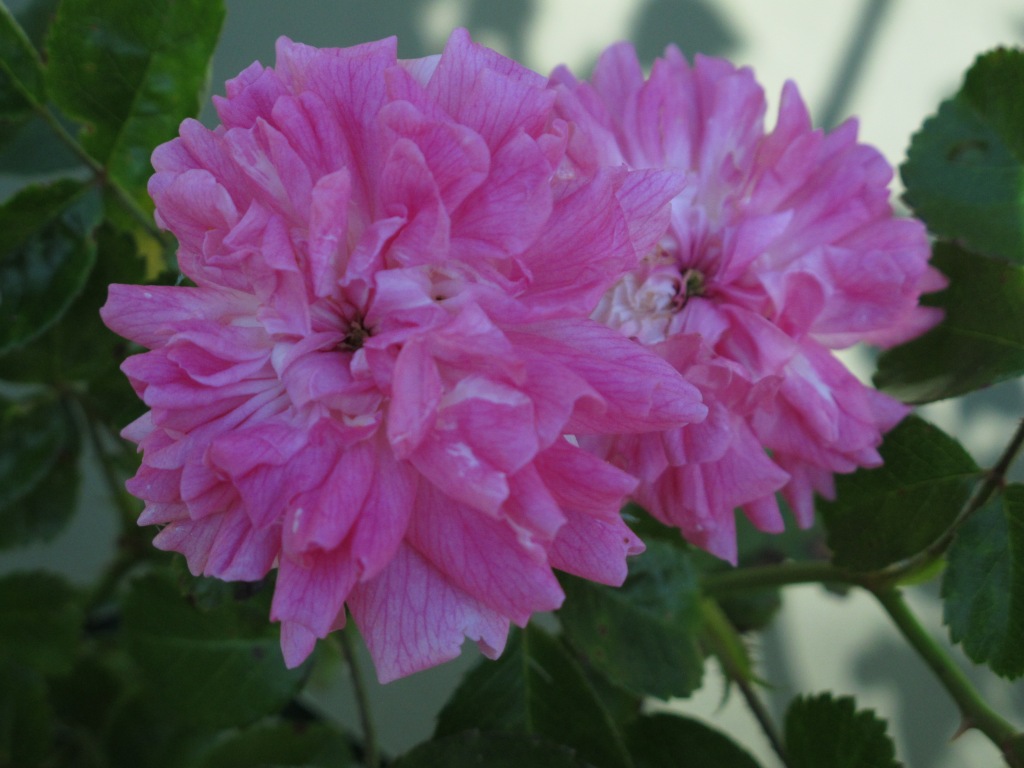
My inventory adds up to quite a few Walsh Ramblers and you would think I would be satisfied, but no, I have the obsessive nature of a true collector. I have been fortunate enough to meet Walsh rose collector Sandy Brown on the internet site, Help Me Find. She lives near Woods Hole, Massachusetts where Michael Walsh did much of his work and where many of his roses can still be found in both public and private gardens. We have arranged to exchange some of the Walsh roses, so I am looking forward to ‘Arcadia’, ‘Bonny Belle’, and ‘Lady Blanche’ from her this year with ‘Snowdrift’, ‘Maid Marion’ and ‘Sweetheart’ on my wish list for the future.
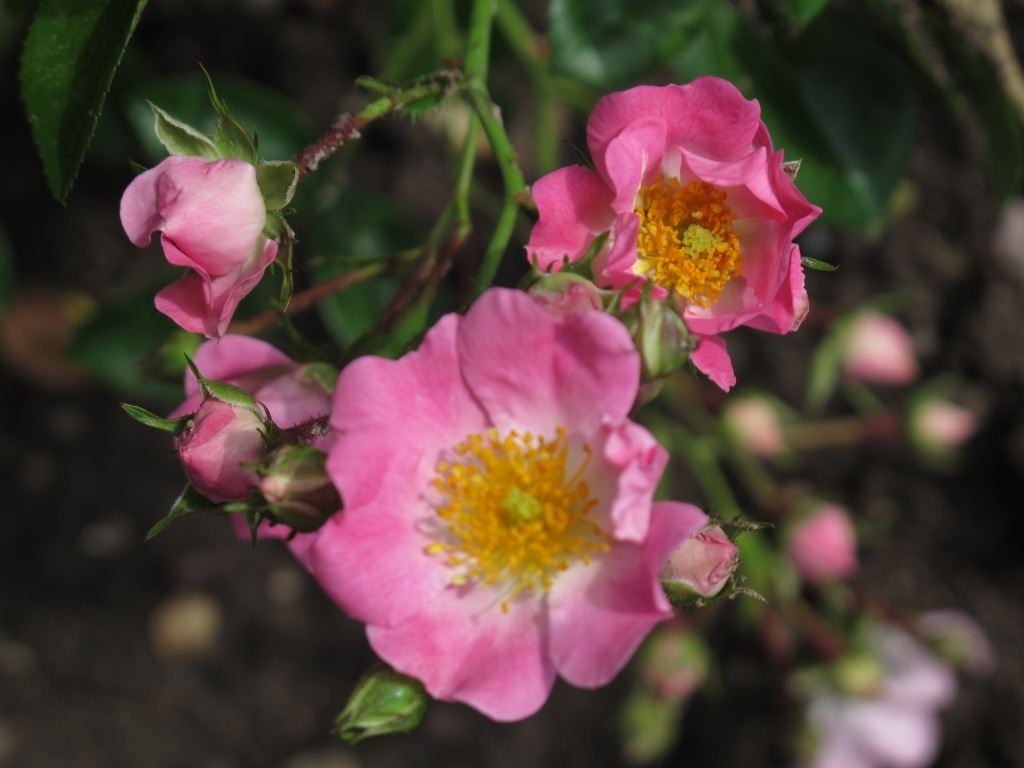
Vintage Gardens rose nursery offers ‘Jessica’, a prize beauty with large, white, blooms nuanced pink, promised to me for delivery in the spring. And in my dreams, my heart travels halfway around the world to the great Europa Rosarium at Sangerhausen, Germany where I know they still grow ‘Carissima’, ‘Coquina’, ‘La Fiamma’, ‘Paradise’, and ‘Wedding Bells’. ‘Carissima’ has a button center and quilled, blush pink petals like a little Dahlia, ‘Coquina’ is a single pink with a cream-white center. ‘La Fiamma’ and ‘Paradise’ are also singles, the first a crimson, the second pink and white with twisted, fimbricated petals. My photograph from Sangerhausen of ‘Wedding Bells’ shows semi-double or lightly double pink roses with lighter outer petals and a touch of cream in the center. Perhaps there is a way to fulfill my longing for these lovely creations.

Proceeding around the circular path of Garden Number Two, I stopped in front of ‘Dorothy Perkins’, the famous pink Jackson and Perkins rose from the beginning of the 19th Century. This rose was actually bred by an employee, named E. Alvin Miller, who dabbled in rose breeding along with other company jobs. It must have been a onetime lucky strike and somewhat ironic that he would create one of the world’s best known roses and then fade into obscurity. The rose breeding job for J & P later went to Jean Henri Nicolas, a French expatriate, who bred some successful roses, among them, ‘Eclipse’, a hybrid tea, and ‘Rochester’, probably the first Floribunda bred by anyone. Nicolas was responsible for suggesting Floribunda as a name for this new class of cluster-flowered bush roses. Nicolas roses are pretty much forgotten now, but Eugene (Gene) Boerner, the man who succeeded him is still famous as Papa Floribunda, the man who created a whole multitude of wonderful Floribunda plus a few very lovely roses from other classes.. His roses are located in other parts of the garden.
Three of the Gene Boerner roses can be found in Garden Number One, so called because it came before Garden Number Two. This is a big fan-shaped garden with a viewing pavilion backed by rose-laden trees at the point of the fan. Most of my Hybrid Teas and Floribundas grow there in tidy curved rows. Among them is the Boerner Floribunda, ‘Goldilocks’, a golden yellow rose, as you would expect from the name. A lattice fence surrounds and partially deer-proofs the garden. One of my special treasures, a Boerner climber named ‘Pink Cloud’ grows on the fence. On an extended European trip, I had seen and admired its large pink flowers with darker centers in one garden after another, but when I attempted to buy it, I found that it had totally vanished from the United States, the country of its origin. Mine is imported from France. A Canadian nursery offers a rose by the same name, but with a somewhat different appearance. ‘Parade’, a similar rose from a slightly later date, can be found on the opposite side of this garden. ‘Aloha’, another Boerner climber, decorates one side of the garage entry with its large flowers in varied shades of rose pink.
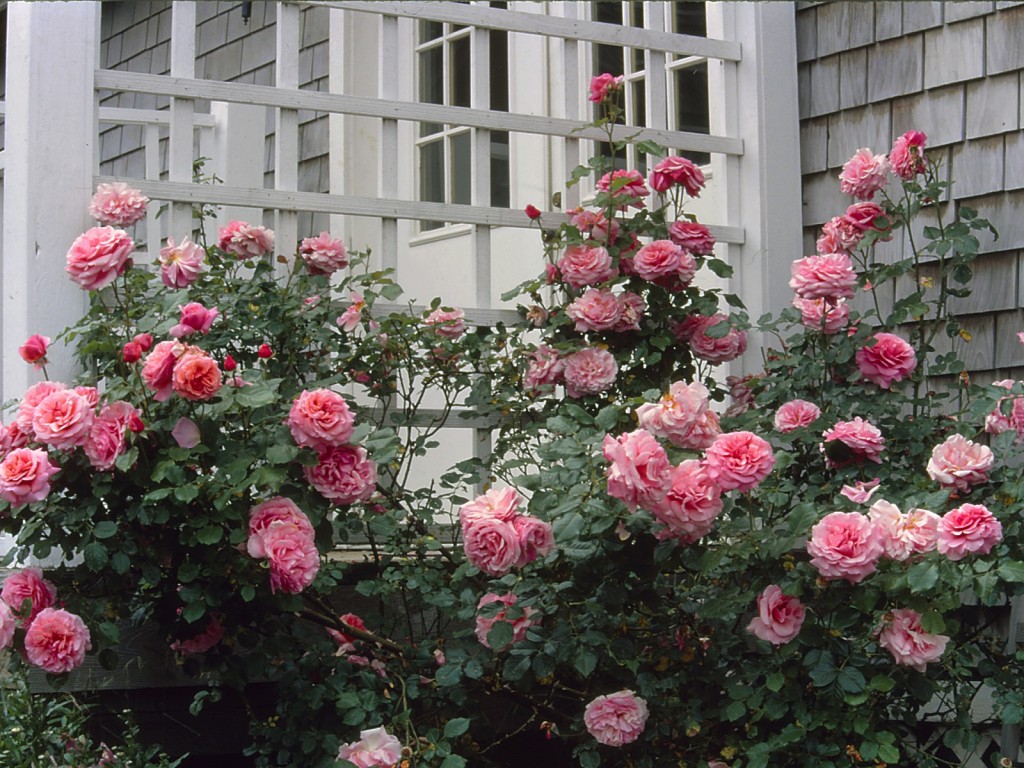
Now, back to Garden Number Two where I left off. ‘Dorothy Perkin’s’ neighbor, two tripods over, is the beautiful ‘Purity’, created by James A. Farrell of the Hoopes Brothers and Thomas Company of Pennsylvania in 1917. Purity’s name must have been inspired by its large, white, virginal appearing flowers. Close by is ‘Christine Wright’, another Hoopes rose, this time with large, pink flowers. Both inherited their flexible growth habit and shiny leaves from Rosa wichurana. ‘Climbing American Beauty’ (a seedling, not a sport of ‘American Beauty’) drapes its deep pink flowers on a fence to the south and rounds out my Hoopes collection. One other from this breeder, ‘Professor C. S. Sargent’, is supposed to grow at the Europa Rosarium in Sangerhausen, Germany, but the rose there by that name is apricot and pink rather than the yellow and buff of the original.
The Hoopes roses always remind me of Dr. Walter Van Fleet’s Hybrid Wichuranas. Dr. Van Fleet was a medical doctor who gave up his practice to work with plants for the Department of Agriculture, and later concentrated on his great passion for hybridizing roses, especially hybrids of Rosa rugosa and Rosa wichurana.
All at once I came to five of the Walter Van Fleet roses, all Hybrid Wichuranas. I looked across to the inner ring and found his ‘Alida Lovett’ and ‘Breeze Hill’. A few steps more took me to ‘Mary Wallace’ and ‘Mary Lovett’ on the outer ring. ‘Alida Lovett’ and ‘Mary Wallace’ are pink, ‘Mary Lovett’ is pure white and ‘Breeze Hill’ is an interesting mixture of coral, buff and cream. All produce, beautiful, large, well-shaped flowers.

A few steps back to the fence that borders our small orchard brings me to ‘Silver Moon’ with large, semi-double, pure white flowers. DNA studies have shown that this lovely rose was bred from Rosa wichurana and ‘Devoniensis’, not from Rosa laevigata as was once thought.
Looking to east I could see the lightly double, delicate pink blooms of the very vigorous ‘Dr. Van Fleet’ rose that covers an entire half of the large pavilion standing next to Garden Number Two. Guests seated in the pavilion on a summer afternoon may find pink petals falling into their wine glasses from this rose. In 1930, ‘Dr. Van Fleet’ sported to the much loved, repeat-flowering ‘New Dawn’, identical in appearance to its parent, but with much less vigor. This was the beginning of the class of modern climbers we call Large-flowered Climbers. ‘Awakening’, a pink, repeat-blooming, fully double sport of New Dawn grows up the back side of the pavilion.

Van Fleet produced roses named after three of the Lovett sisters, but I only have two. The one missing from my garden is ‘Bess Lovett’, a double deep pink or bright crimson, close in color to that of ‘Climbing American Beauty’ or ‘American Pillar’. When mine was a very small, own root rose, someone sideswiped it with a weed whacker and it didn’t live through the winter in its weakened state. I confidently ordered a new one from Vintage Gardens, the single nursery in this country to list it, only to learn that they had lost the rose as well. Harald Enders, a rose friend in Germany ordered one for me from a European nursery but was told by some rose experts there that it was the wrong rose. The nursery may have got their plant from the Sangerhausen garden because the photographs taken there and shown on Help Me Find reveal light pink blooms, not crimson ones, as they should be.
This treasure was not to be easily uncovered. I contacted the curator of the Cranford Rose Garden in Brooklyn where ‘Bess Lovett’ is growing and was told that their plant was being kept in isolation because it possibly had contracted the viral rose rosette disease. Saddened, I turned to Help Me Find for a listing of gardens and nurseries where ‘Bess Lovett’ was located. One was Hartwood Roses, a small nursery in Virginia owned by Connie Hilker. I was able to contact her through HMF. She sent me a photograph of her rose that had come from Nick Weber’s Heritage Rosarium in Maryland. Nick had obtained it from the USDA Beltsville research test grounds, where Dr. Van Fleet worked on breeding cold hardy roses. It had been labeled simply “Pink Van Fleet”, not ‘Bess Lovett’, but Nick thought it matched the descriptions of that rose. He managed to get some cuttings before the place was bulldozed in the 1970’s. I thought the rose in Connie’s photograph was not double enough or dark enough to be Bess Lovett. It began to look like this important rose had become extinct without our even being aware of this danger.
I’m holding onto two points of hope. Connie Hilker will send me a plant of the “Pink Van Fleet and maybe I will be assured that it is the right one when I can see the color and morphology of the actual flowers. A photograph of ‘Bess Lovett’ by Etienne Bouret (AmiRoses) of France on Help Me Find matches the older descriptions of the rose. Etienne has informed me that he took the photo at Vrijbroek Park in Belgium. He will try to obtain cuttings and have them propagated. Etienne, a photographer and devoted rose gardener, has already obtained an important selection of historic roses for me from the Roseraie du Val-de-Marne, including ‘Ruby Queen’, a Van Fleet rose long lost from this country. Additionally, I grow the pink ‘May Queen’ on one of my fences. I’m searching for the true ‘Pearl Queen’, called ‘Queen of Pearl’ in Europe, to complete my set of the three queens. The one I imported a several years ago turned out to be an imposter. I was more fortunate in importing ‘Philadelphia’ (‘Philadelphia Rambler’), an offspring of ‘Turner’s Crimson Rambler’. Similar, but with brighter, fuller flowers and greater disease resistance, it is an improvement on its parent.
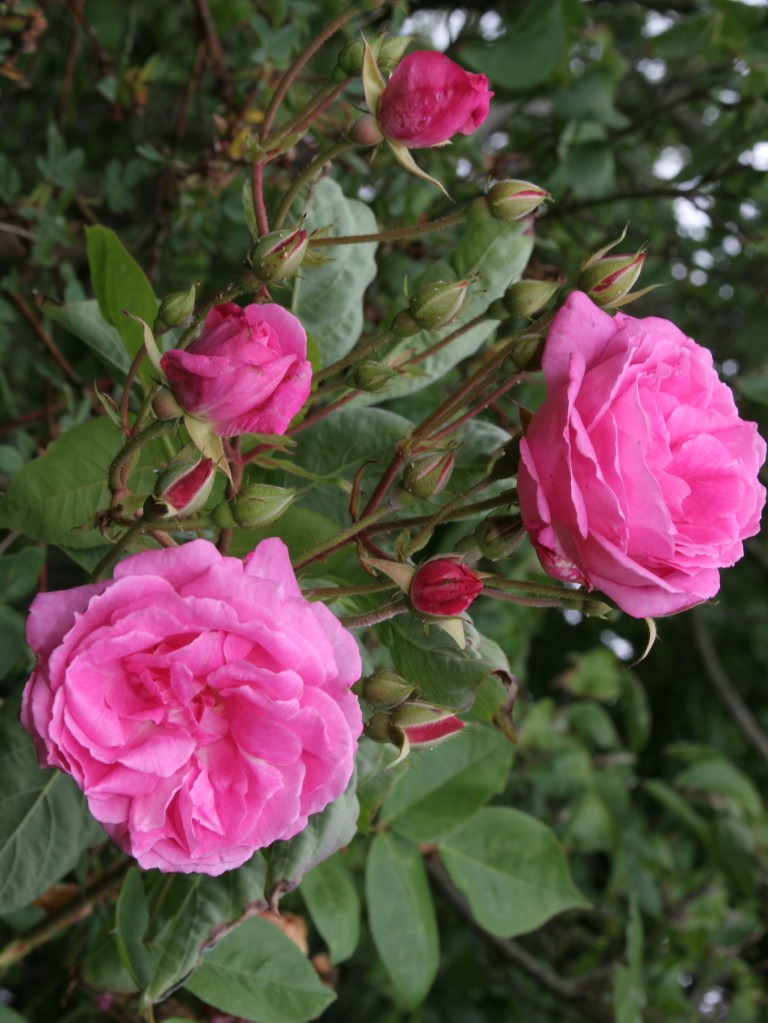
‘Birdie Blye’ is also a Multiflora hybrid, somewhat like a Hybrid Musk. The flowers are reminiscent of ‘New Dawn’, but darker pink. A much less vigorous grower, it climbs feebly into the lower branches of one of our small Dogwoods. Another with similar habits and appearance is the China and Tea hybrid, ‘Beauty of Rosemawr’, which broke my heart winter before last when it succumbed to our record low temperatures and died.
This completes my collection of the Van Fleet roses and, with the exception of ‘Heart of Gold’, the Wichurana/Moyesii shrub climber, it also accounts for all of his climbing types that still exist. Heart of Gold is still grown in several German public gardens. I’ve decided to add his shrubs, mostly Rugosa hybrids, to my garden. Quite a few are still available, some from nurseries in this country. Dr. E. M. Mills (Hybrid Hugonis) and New Century (Hybrid Rugosa) have been ordered from Europe. The Hybrid Rugosas, ‘Ruskin’, ‘Sarah Van Fleet’, ‘Sir Thomas Lipton’, and ‘Rugosa Magnifica’ can easily be found at American nurseries.
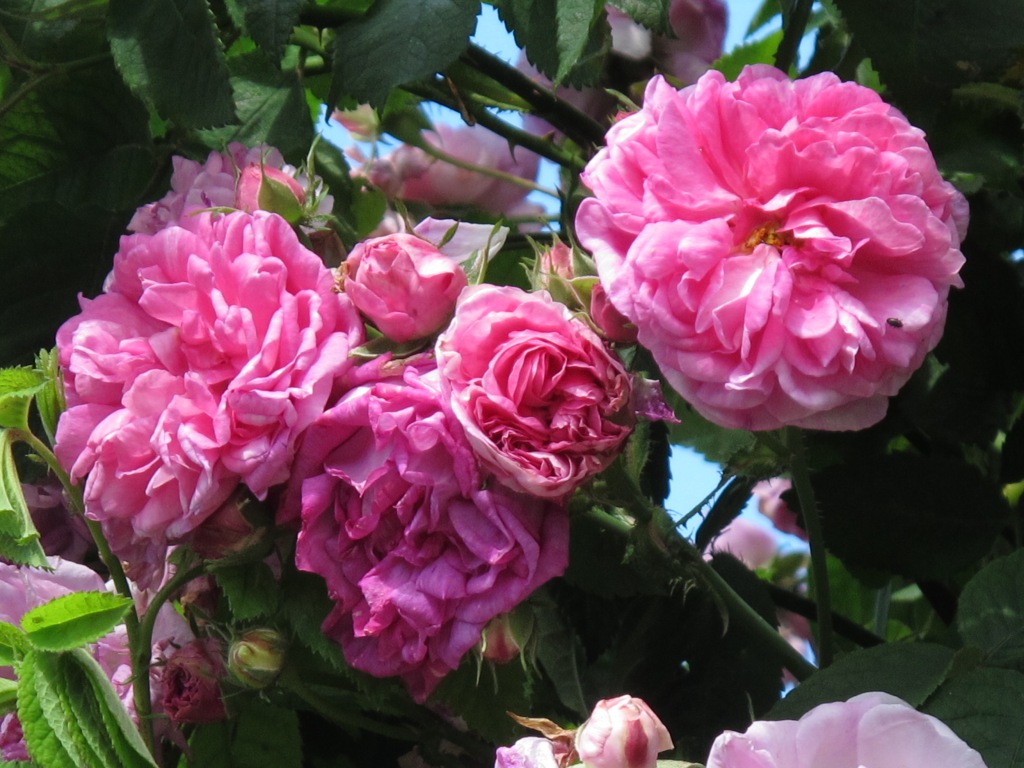
Continuing on around the circular path of Garden Number Two, I recognized ‘Queen of the Prairies’ bred by Samuel and John Feast of Baltimore Maryland and thought to be a Setigera/Gallica cross. The large, double flowers open light crimson and fade to very light pink. This rose is quite different from ‘Baltimore Belle, my other Feast Setigera Hybrid where the influence of the Noisette parent is revealed in its more delicate, appearance. The clusters dip down, and then the deep pink buds and full, pink and white flowers turn gracefully upward. I am trying to add a third rose to my Feast group with no luck so far, but still with hope. I visited the Park de la Tête d’Or in Lyon, France a number of years ago and was totally astonished to come upon ‘Superba’, a Feast Setigera Hybrid thought to no longer exist. Fabien Ducher of the famous Ducher rose breeding family in Lyon has offered to try to get a plant of Superba propagated for me, but has been hampered so far by the poor condition of the plant in the park.
Now, I may have discovered another rose treasure growing in this same garden. I have a plant sold to me as ‘Gem of the Prairies’ (syn. ‘Bijou des Prairies’) growing close by to ‘Queen of the Prairies’. Bred by Burgesse of New York in 1860, it is now unfortunately one of those old roses with a questionable identity. The full flowers are dark crimson with a band of almost white petals around the outer edge. The same identical flowers appear on roses sold as ‘Geschwind’s Orden’. Is one of them correct? Which one? ‘Geschwind’s Orden’ was described in earlier literature as having flowers of deep violet-pink or crimson with white edging. This description matches the appearance of the ‘Geschwind’s Orden’ presently on the market as well as mine. ‘Gem of the Prairies’ was earlier described as having light crimson or rosy pink flowers shaded or blotched with white. A photograph of ‘Gem of the Prairies’ taken at the Park de la Tête d’Or by Etienne Bouret and shown on Help Me Find matches this description remarkably well. Perhaps we have discovered the true variety.

I had almost come to the end of the outer ring of my circles of tripods when I stopped in front of ‘Gardenia’ to admire its soft creamy yellow blooms and shiny leaves and I knew I was back with the Hybrid Wichuranas. Michael Horvath, originally from Hungary, first worked for Manda and Pitcher in New Jersey breeding Wichurana Hybrids. Manda is perhaps wrongly given credit for some of these roses that he introduced but did not breed. Which ones is unclear, so I am assigning them all to Horvath (with Manda), as is done in Brent Dickerson’s Roll Call: The Old Rose Breeder. I have recently acquired two rare Horvath/Manda roses from this period, both from the Roseraie du Val-de-Marne at L’Haÿ, France. ‘Pink Roamer’, a single with clusters of small, white centered deep pink flowers makes a dainty presentation. ‘South Orange Perfection’ has small, double pink and white flowers, not orange as the name might fool you into thinking. It was named for South Orange, New Jersey where Horvath worked. I have two more ordered. ‘Jersey Beauty’ with delicate, single cream/white flowers, powerful climbing ability will be coming from Vintage Gardens. ‘Universal Favorite’, with very small double flowers of pink and white has been ordered from the Francia Thauvin nursery in France.

Later, Horvath moved to Ohio where he bred Setigera Hybrids to withstand the bitterly cold winters there. He charmingly named some of them after characters in Robert Louis Stevenson’s Treasure Island. I have the excellent crimson red climbers, ‘Thor’ and ‘Captain Kidd’ growing on fences. ‘Long John Silver’, also a fence inhabitant, produces exceptionally lovely double white blooms attached by long stems to a unexpectedly awkward, coarse plant. Some people have questioned its identity, suggesting that it is really another Horvath rose called ‘Iceland Queen’. There is a rose grown under the name of ‘Iceland Queen’ at the Cranford Rose Garden in New Jersey that is distinct from what is being sold as ‘Long John Silver’ and which I believe is correctly named.
Of course I can’t stop here. I have ordered ‘Doubloons’, an impressive yellow and ‘Jean Lafitte’, a white with touches of pink at the center–a strangely delicate rose to carry the name of a pirate. Some of the roses sold here and abroad as ‘Eurydice’ (Geschwind) are actually thought to be Jean Lafitte, so beware. As usual, I have a hope list. ‘Buff King’ is listed among the plants at The Garden of Roses of Legend and Romance in Wooster, Ohio which was funded by Horvath’s daughter. ‘Manda’s Triumph’ and ‘Mrs. F. F. Prentiss’ sit safely at Sangerhausen. ‘Pink Pearl’ resides at the Roseraie du Val-de-Marne. They all seem within reach in my dreams.
I walked on and then stopped to see the Brownell rose ‘Elegance’ truly living up to its name with elegant yellow buds on long stems opening up Hybrid Tea-like and fading softly at the petal edges. It is an excellent source of cut flowers and is remarkably cold hardy for a yellow rose. Walter and Josephine Brownell were a husband and wife team living in Little Compton, New Jersey and worked from the 1920’s to late in the 1950’s creating cold hardy roses that they called sub-zero roses. The foundation roses for their breeding program were the Van Fleet Wichurana Hybrids ‘Dr. W. Van Fleet’, ‘Glen Dale’, and ‘Mary Wallace’ which they must have thought were more hardy than is actually the case. Brownell roses will withstand some fairly cold temperatures, but not sub-zero ones. However, many of their roses are very beautiful and most are quite disease resistant. Their ‘Mrs. Arthur Curtiss James’ is on a tripod a few steps away from ‘Elegance’ and completes the circle path. It, too, is a yellow, but brighter and opens out more to show its dark yellow stamens.

Now, I needed to take a tour around a larger area to see the rest of my Brownell varieties. I stepped over to Garden Number One where modern bush roses are enclosed in a lattice fence that supports many of my climbers and checked out ‘White Cap’, a superb white, very double LCl. As usual, this constantly repeating wonder was covered with blooms. Walking across to look at ‘Golden Arctic’, I admired the large pink flowers with rolled back petals on ‘Curly Pink’, a Hybrid Tea that I think would like to climb a little if it had a support. ‘Golden Arctic’ presents antique-like golden yellow flowers with a touch of crimson on the buds.
Our property has a boundary fence going clear around all five acres and across in several places to keep our dogs in and other animals out. A failure in the case of deer, it serves us well otherwise, not only as a barrier, but as a great support for climbing roses. If I walked around this fence I would see my remaining Brownells; ‘Apricot Glow’, ‘Coral Creeper’, ‘Golden Glow’, ‘Show Garden’, and ‘Orange Everglow’, All are climbers and, with the exception of ‘Show Garden, a deep pink, they are various shades of yellow and coral. ‘Coral Creeper’ is really a climber and such is the case, as well, with ‘Little Compton Creeper’ which I don’t grow yet. To top this list off, ‘Nearly Wild’, a shrubby Floribunda with clusters of pretty, single, deep pink flowers grows under a small dogwood. ‘Rhode Island Red’, an LCL, has just arrived and waits in the greenhouse for a permanent place to grow.


The Brownells bred a substantial number of Hybrid Teas, but you will notice that I have only one on my list. The main focus of my interest in roses has always been climbers. Hybrid Teas have been planted for their beauty, serving as garden decorations and a source of cut flowers. Any pretty ones that came along have always been welcome to take a place in Garden Number One. If one died, I replaced it in a practical way with whatever was attractive and readily available. They were never part of a collection of special significance for me. Now, that will change with my new interest in early American bred roses.
I am looking for sources of antique varieties of Hybrid Teas and Floribundas in this group. Vintage Gardens has a good repertoire of old Hybrid Teas and Floribundas, not only those from the Brownells, but a number of varieties by such important breeders as E. Gurney Hill and his son, J. H. Hill of Indiana, Fred Howard of California, Gene Boerner of Floribunda fame, and John Cook of Maryland. They all produced significant numbers of these roses during the first half of the 20th century. Even though quite a few are still available, a great loss to our gardens and commercial sources has still occurred with this group. Many of those missing from the nursery plant lists can be found in the Europa Rosarium at Sangerhausen, Germany, and a few in the Roseraie du Val-de-Marne at L’Hay-les-Roses, France and other European public gardens. This type of rose is often ignored by people who are interested in growing and preserving heritage roses because they think of them as being modern, but we should remember that most of the roses by the above hybridizers are between 50 and 100 years old and they are an important part of our American rose heritage. An attempt should be made to recover them, place them in public gardens where possible, and make them commercially available once more.

Thank you for letting us read Anne’s account of some of her roses. I enjoyed it, esp. as here in Federal Way we have a setigera identified by Judi Dexter as possibly ‘Queen of the Prairies’ planted in the Heritage Garden near the Denny Cabin. It came from Illinois and through two other people before arriving here. Now we can compare what it looks like with Anne’s rose.
LikeLiked by 1 person
Hi Teddie,
I worked with Anne to design and publish her rose books plus the one of her sail across the Pacific.
LikeLiked by 1 person